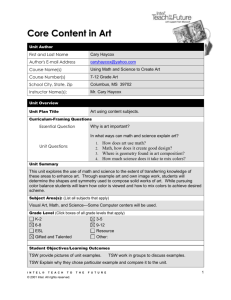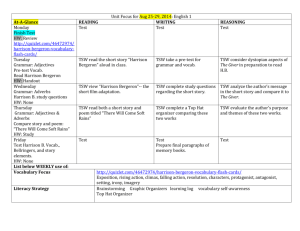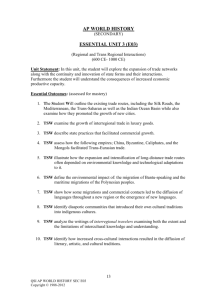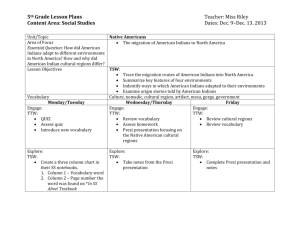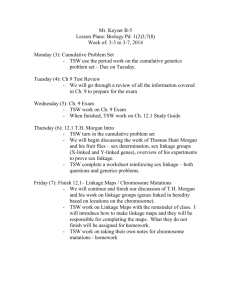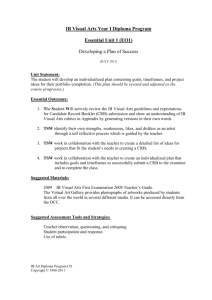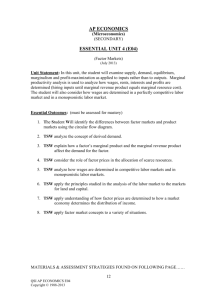E06GeneRegulation
advertisement
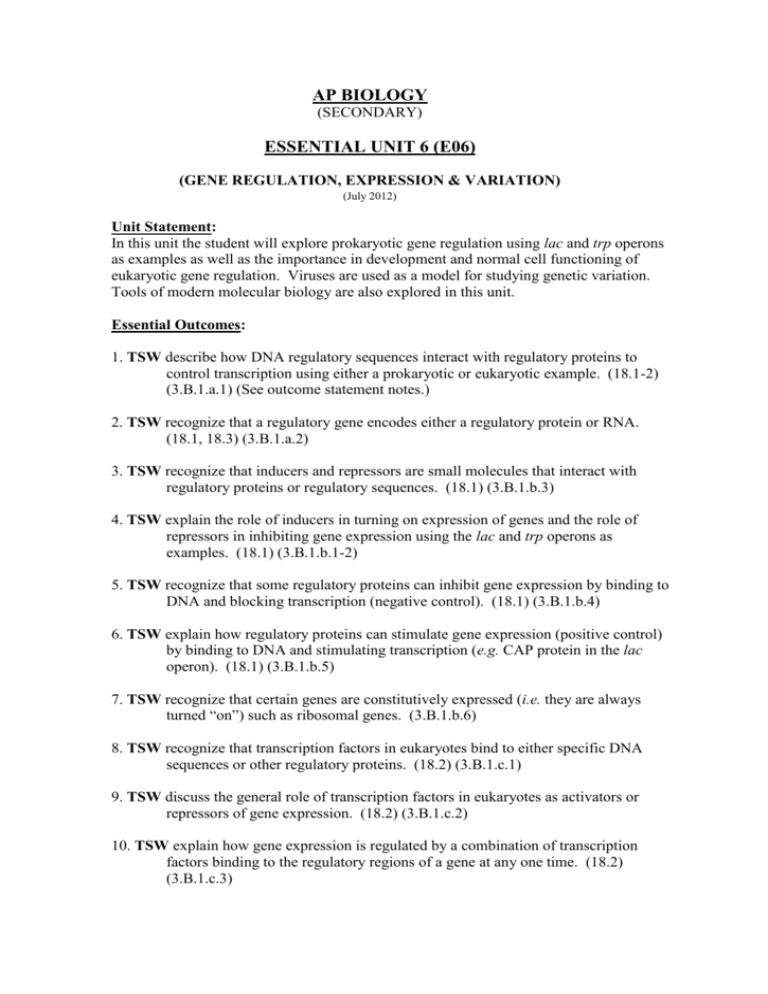
AP BIOLOGY (SECONDARY) ESSENTIAL UNIT 6 (E06) (GENE REGULATION, EXPRESSION & VARIATION) (July 2012) Unit Statement: In this unit the student will explore prokaryotic gene regulation using lac and trp operons as examples as well as the importance in development and normal cell functioning of eukaryotic gene regulation. Viruses are used as a model for studying genetic variation. Tools of modern molecular biology are also explored in this unit. Essential Outcomes: 1. TSW describe how DNA regulatory sequences interact with regulatory proteins to control transcription using either a prokaryotic or eukaryotic example. (18.1-2) (3.B.1.a.1) (See outcome statement notes.) 2. TSW recognize that a regulatory gene encodes either a regulatory protein or RNA. (18.1, 18.3) (3.B.1.a.2) 3. TSW recognize that inducers and repressors are small molecules that interact with regulatory proteins or regulatory sequences. (18.1) (3.B.1.b.3) 4. TSW explain the role of inducers in turning on expression of genes and the role of repressors in inhibiting gene expression using the lac and trp operons as examples. (18.1) (3.B.1.b.1-2) 5. TSW recognize that some regulatory proteins can inhibit gene expression by binding to DNA and blocking transcription (negative control). (18.1) (3.B.1.b.4) 6. TSW explain how regulatory proteins can stimulate gene expression (positive control) by binding to DNA and stimulating transcription (e.g. CAP protein in the lac operon). (18.1) (3.B.1.b.5) 7. TSW recognize that certain genes are constitutively expressed (i.e. they are always turned “on”) such as ribosomal genes. (3.B.1.b.6) 8. TSW recognize that transcription factors in eukaryotes bind to either specific DNA sequences or other regulatory proteins. (18.2) (3.B.1.c.1) 9. TSW discuss the general role of transcription factors in eukaryotes as activators or repressors of gene expression. (18.2) (3.B.1.c.2) 10. TSW explain how gene expression is regulated by a combination of transcription factors binding to the regulatory regions of a gene at any one time. (18.2) (3.B.1.c.3) 11. TSW recognize that regulation of gene expression can account for some of the phenotypic differences between organisms with similar genes. (3.B.1.d) (See outcome statement notes.) 12. TSW describe the connection between the regulation of gene expression and the observed differences between different kinds of organisms and between individuals in a population. (LO 3.18-3.19) (SP 7.1) 13. TSW explain how the regulation of gene expression is essential for the processes and structures that support efficient cell function. (18 Introduction) (LO 3.20) (SP 6.2) 14. TSW use representations or models to explain how gene regulation affects the products produced by a cell and the cell’s function. (LO 3.21) (SP 1.4) (See suggested assessments and teaching strategies.) 15. TSW describe how differential gene expression leads to the production of tissue specific proteins, and ultimately, observable cell differentiation. (18.2, 18.4) (2.E.1.a) 16. TSW describe the role of RNA interference (RNAi) in gene expression at the level of mRNA transcription. (18.3) (3.A. 1.b.4.iv) 17. TSW recognize that sequential gene expression is the result of induction of transcription factors during development. (18.4) (2.E.1.b & 2.E.1.b.2) (See outcome statement notes.) 18. TSW recognize that homeotic genes control developmental pattern formation and sequencing. (18.4) (2.E.1.b.1) 19. TSW recognize that genetic mutations can result in abnormal development. (18.4) (2.E.1.b.4) 20. TSW explain how genetic transformation experiments show the connection between gene expression and normal development. (18.4) (2.E.1.b.5) 21. TSW recognize the importance of microRNAs in gene regulation in development and control of cellular processes. (18.4) (2.E.1.b.4) 22. TSW interpret and analyze graphs or diagrams involving the timing and coordination of events necessary for normal development of an organism. (LO 2.32) (See outcome statement notes.) 23. TSW explain, using scientific evidence, that timing and coordination of several events are necessary for normal development and that these events are regulated by multiple mechanisms such as cytoplasmic determinants, embryonic induction and sequential gene activation initiated by master regulatory genes (18.4) (LO 2.33) (SP 6.1) 24. TSW recognize that differentiation of cells in development results from internal and external cues that affect gene regulation by DNA binding proteins. (18.4) (4.A.3.a) 25. TSW recognize that determination, and ultimately, differentiation into structurally and functionally divergent cells depends upon tissue (or organ) specific gene expression. (18.4) (4.A.3.b) 26. TSW recognize that environmental stimuli such as chemical carcinogens, high-energy radiation or X-rays can affect gene expression in mature cells. (18.5) (4.A.3.c) 27. TSW create and refine drawings to illustrate how external stimuli and gene expression interact to result in specialization of cells, tissues and organs. (18.4) (LO 4.7) 28. TSW relate, using an example, changes at the cellular level with physiological events that they regulate. (LO 2.37) (SP 7.2) 29. TSW describe the flow of genetic information in retroviruses from RNA to DNA made possible by the enzyme reverse transcriptase. (19.2) (3.A.1.a.6) 30. TSW describe how retrovirus reproduction involves copying of the viral RNA genome into DNA, integration of this DNA into the host cell genome, and transcription and translation of this viral DNA for assembly of new viruses. (19.2) (3.A.1.a.6) 31. TSW recognize that viruses have highly efficient replicative capabilities that allow for rapid evolution and acquisition of new phenotypes. (19.1-2) (3.C.3.a.1) (See outcome statement notes.) 32. TSW recognize that viruses replicate by assembly of component parts allowing one virus to produce many progeny simultaneously in the lytic cycle. (19.1-2) (3.C.3.a.2) 33. TSW recognize that some viruses are able to integrate into the host cell genome to establish a lysogenic infection that can confer new properties for the host such as increased pathogenicity. (19.2-3) (3.C.3.b.2) 34. TSW recognize that mutations can arise through usual host pathways as viruses replicate. (19.2) (3.C.3.a.3) (See outcome statement note for TSW 31.) 35. TSW recognize that RNA viruses lack replication error-checking mechanisms and as a result have higher rates of mutation. (19.3, cf. 23.1 Rapid Reproduction) (3.C.3.a.4) 36. TSW recognize that related viruses that combine/recombine information if they infect the same host cell. (19.1-2 for background) (3.C.3.a.5) (See outcome statement note for TSW 31.) 37. TSW recognize that HIV is a well-studied example of how rapid evolution of a virus contributes to the pathogenicity of viral infection. (19.1-2 for background) (3.C.3.a.6) (See outcome statement note for TSW 31.) 38. TSW explain how viruses can introduce genetic variation in host organisms. (LO 3.29) (SP 6.2) (See TSW 31-37, 46) 39. TSW explain how genetic variation is introduced into the viral population through viral replication. (LO 3.30) (SP 1.4) 40. TSW recognize the importance of genetic engineering techniques in manipulating the heritable information of DNA and, in some cases, RNA and will explain at least two commonly used technologies. (20.1-2) (3.A. 1.e) (also LO 3.5) (See outcome statement notes and suggested assessments and teaching strategies.) 41. TSW cite practical applications of genetic engineering. (20.3-4) (3.A. 1.f) (See outcome statement notes.) 42. TSW recognize that multiple copies of genes (gene duplication) may provide new phenotypes. (21.5) (4.C.1.b) 43. TSW explain how gene duplication in which one copy of the gene retains the original function and the second copy undergoes changes to produce a polypeptide with a new function allows for the evolution of genes with new functions. (21.5) (4.C.1.b.2) (See outcome statement notes.) 44. TSW recognize that viruses, prokaryotes and eukaryotes can contain plasmids, which are small, extra-chromosomal double-stranded DNA molecules. (27.1) (3.A.1.a.3) (See outcome statement notes.) 45. TSW discuss the role of horizontal transfer of genetic information (horizontal gene transfer) in increasing variation primarily in prokaryotes. (Horizontal gene transfer includes transformation, transduction, conjugation, and transposition.) (27.2, 21.4-5) (3.C.2.b) (See outcome statement notes.) 46. TSW recognize that viruses transmit DNA or RNA when they infect a host cell. (27.2) (3.C.3.b.1) (See outcome statement notes.) 47. TSW actively engage in laboratory exercises that fulfill the College Board requirements for 2 labs in each of the 4 big idea areas as directed by the instructor. Outcome Statement Notes: 1. The instructor may use one or more of these illustrative examples or another to promote student understanding of this concept: promoters (18.1), terminators (17.2) or enhancers (18.2). [TSW 1] 2. An example for this objective may be the very different appearance of different breeds of dogs despite the similarities their genes. [TSW 11] 3. Memorization of the specific stages of embryonic development is not within the scope of this course and will not be tested on the AP exam. [TSW 17] 4. This requirement specified by College Board in the AP Biology Curriculum Framework is intended to develop the skill of using representations and models to analyze a situation or solve a problem. A graph or diagram could be produced by the student or, a textbook example may be used. A fairly simple diagram in Campbell Biology 9th Edition illustrates the sequential steps of determination and differentiation of skeletal muscle cells (18.4). It is not readily apparent why this topic was chosen to develop this skill as it does not appear to lend itself readily to this type of analysis though throughout the AP biology course, instructors should keep in mind the goal of developing in students certain skills identified by College board as typical requirements for a similar university course. [TSW 22] 5. This TSW is not specifically supported by the Campbell Biology text. Viruses as a stand-alone topic is not a part of the current AP Biology curriculum, but rather viruses are used to teach that heritable genetic material may be DNA or RNA (see TSW 3, EO 1) and that genetic variation can occur in viruses through replication errors involving host or viral processes. This second point is the focus of what should be taught for this TSW. For an example of a review article on the topic of genetic variation in viruses, see Retrovirus mutation rates and their role in genetic variation at http://vir.sgmjournals.org/cgi/reprint/79/6/1337.pdf. [TSW 31] 6. The instructor may use one or more of these illustrative examples or another to promote student understanding of this concept: electrophoresis (20.2), plasmid-based transformation (20.1), restriction enzyme analysis of DNA (e.g. RFLP analysis) (20.2) or polymerase chain reaction (PCR) (20.1). [TSW 40] 7. Students should be able to use an illustrative example like genetically modified foods (20.4), transgenic animals (20.4), cloned animals (20.3) or pharmaceuticals, such as human insulin or factor X (20.4). [TSW 41] 8. College Board identifies only the antifreeze gene in fish as an illustrative example. Campbell Biology provides an example using the α-globin and β-globin gene families. [TSW 43] 9. The Campbell Biology text discusses plasmids in the context of prokaryotes only. The text acknowledges that some viruses have double-stranded chromosomes but does not refer to the presence of extra-chromosomal plasmids. For eukaryotes, plasmids are mentioned only in reference to eukaryotic gene cloning in prokaryotes or in the production of transgenic plants using the prokaryotic Ti-plasmid. [TSW 44] 10. College Board states that the details and specifics about the processes are beyond the scope of the course and AP exam. [TSW 45] 11. The instructor may use one or more of these illustrative examples or another to promote student understanding of this concept: transduction in bacteria (27.2) or transposons present in incoming DNA. [TSW 46] Suggested Assessment Tools and Strategies: 1. Instructors may use Activity 18.2 in Practicing Biology for modeling the lac and trp operons. [TSW 14] 2. The instructor may use activity 20.1 in Practicing Biology for illustrating gene cloning into a bacterial plasmid, activity 20.2 for PCR, or activity 21.1 for DNA sequencing. [TSW 40]

